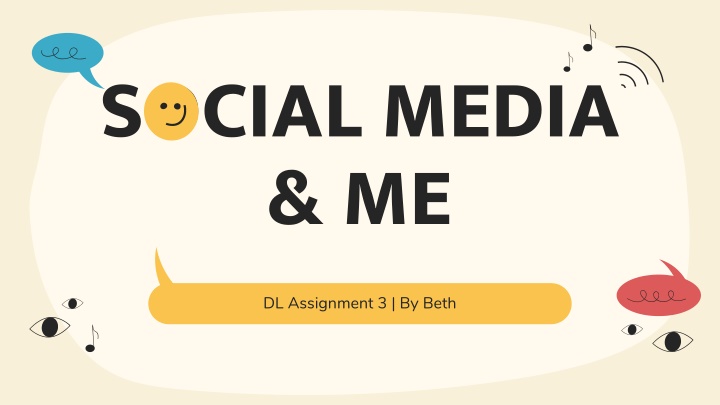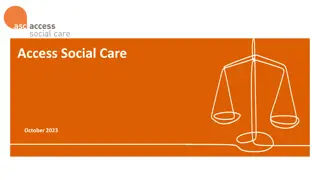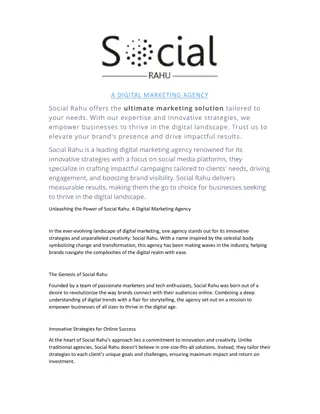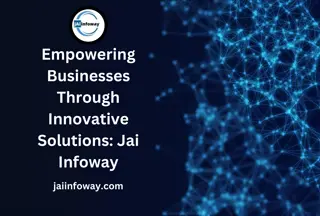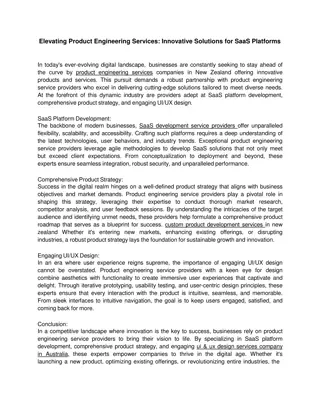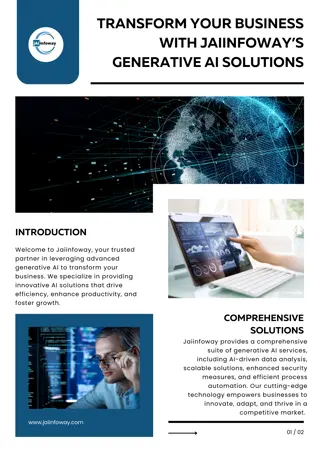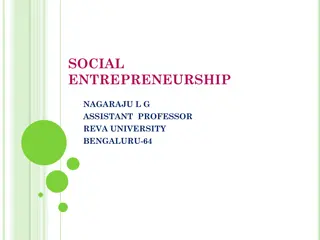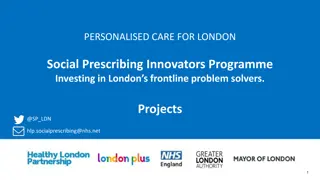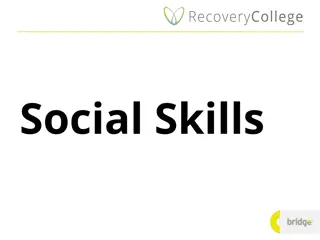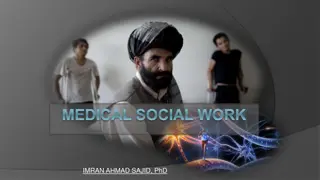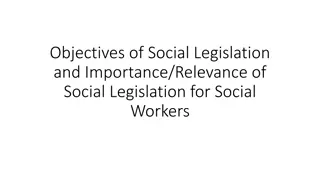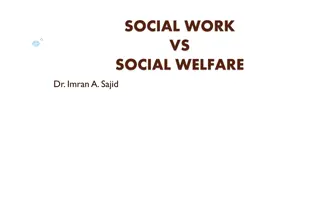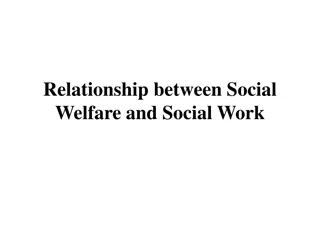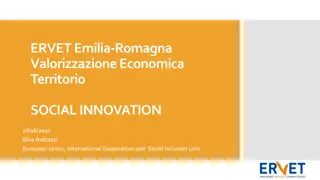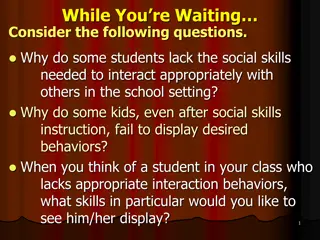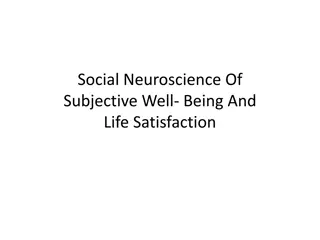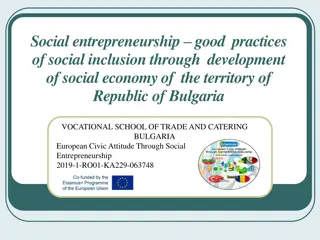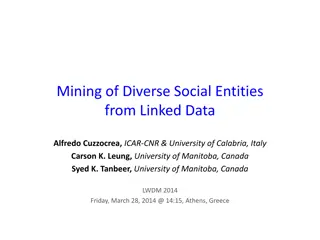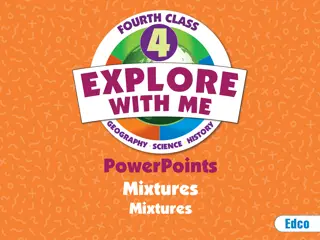Innovative Solutions for Social Challenges
Innovative solutions to social problems require a clear understanding of the people affected, community dynamics, and policy environments. The Levitt Challenge Framework emphasizes the importance of considering diverse perspectives and ecosystems when addressing social issues. Understanding the differences between recipients, beneficiaries, and donors is crucial. Evaluating community ecosystems and conducting ecosystem assessments can identify opportunities and barriers for success. Research plays a key role in uncovering biases, perceptions, and assumptions to develop effective solutions.
Download Presentation

Please find below an Image/Link to download the presentation.
The content on the website is provided AS IS for your information and personal use only. It may not be sold, licensed, or shared on other websites without obtaining consent from the author.If you encounter any issues during the download, it is possible that the publisher has removed the file from their server.
You are allowed to download the files provided on this website for personal or commercial use, subject to the condition that they are used lawfully. All files are the property of their respective owners.
The content on the website is provided AS IS for your information and personal use only. It may not be sold, licensed, or shared on other websites without obtaining consent from the author.
E N D
Presentation Transcript
SOCIAL MEDIA & ME DL Assignment 3 | By Beth
SECTION ONE SELF REFLECTION
How have social media platforms changed the way you consume and understand information? When I view media, the likelihood of me taking that media seriously depends on the source of information. This is the same across all platforms, whether I m reading an article from a trusted news source or from somebody s Instagram account. If I see that the information that I am looking at seems likely to be real, then I will look at the source it comes from and determine whether it seems reliable. However, although this is a good strategy to have, I believe I am more likely to fall back on it because I have grown up with social media in my life, which means I know how many people will ramble on about facts they haven t researched properly, leading to further misinformation. Social media has made me more cautious of misinformation and how easily it can be spread across large groups of people, so I tend to be more skeptic of information until I have confirmed it is from a reliable source.
I will admit that I dont research every fact or informational post I find on social media. This is because most of the time, I m on social media just to relax and scroll through cat videos, so I m not super interested in checking the validity of an article I m probably just going to scroll past anyways. However, if I do find something about a topic I m interested in, I will take the time to consider a few points before I decide what to do next: First, I will decide whether I will be in a situation where I will share this information with anyone. This is because I need to consider if it may affect anyone else if I share information which might be untrue. Then, I consider if it will affect my own understanding of the topic, so I don t subconsciously filter misinformation to myself. If I answer yes to either of these questions, I will dig deeper on a platform that is not social media and only use trustworthy sources until I find the reliable answer. When you see or read news on social media, do you take time to research the story further?
02 WATCH THIS VIDEO: https://bit.ly/2unykti
What value do you get from online social interactions? I don t post on any of my social media, but I do like other people s posts and comment on some of my close friends posts. Because of this, I don t really have many online interactions that are popularity based, determined by likes and comments and shares. The online interactions I do have are through text messages on different platforms, but even then, I only text my close friends and family.
How is social media and social capital helping to form youth culture? Much of this generation has grown up on technology and social media. This has influenced many aspects of culture, such as trends, interests, and how people interact with each other and the world around them. Because youth today are so interconnected with social media, the things they see become such an influential part of their lives that it factors into parts of their personality and affects all aspects of their lives. Unfortunately, there can be negative impacts, like cyberbullying, disruptions schedules, misinformation, and representations of other people s lives, but that s not all there is to it. Social media is also a key tool to connect people around the world to international products, their peers, education and work experiences, and far more. from daily unrealistic comparisons to
When you post online do you consider how the post may be seen by others? I don t post on social media at all, even on my story. Because of this, I don t worry about what my posts say about me, but I do take the time to recognize that everyone who follows me can see what posts I like or comment on, or which accounts I follow. It s less of a viewed upon thing in terms of how it may reflect my image in the future. However, it still reflects my behaviour just like anything else does on social media, so I make sure to always have that in mind when I interact with posts.
03 CONSIDER The future Black Mirror, Nosedive, trecho (youtube.com) Kindness may not deserve kind return (youtube.com)
Do you see any similarities between the world presented in this video and the world you live in? The connected to the real world. First, when she looks at the other characters, she sees a sort of rating for them which goes up and down based on their social media presence. This resembles a sort of unconscious bias people may have towards each other based on what they may share through social media. There also seems to be a pressure to interact on social media, to post things and support other people s posts rather than risk hurting anyone s feelings, which can be seen in real life as well. character s world shows several things that I
HOW DOES THE MAIN CHARACTER INTERACT WITH HER POINTS? The main character s points are every important to her. She gains and loses points based on how others rate her, and she can rate others in return. They re important to her because they are a public display of her popularity. As shown in the second clip, someone s rating may reflect the way others view them. This is seen in real life as well, how peer pressure and a group mindset can affect the thoughts of an individual.
What value might be derived from this type of social interaction? The way these characters interact with each other and their points seems very similar to a kind of popularity contest. The value they get from being rated makes them feel more important, which feeds into their egos and leads them to rate more people and interact more and delve deeper and deeper into the rabbit hole. It s a cycle that keeps them in, and paired with the reality of FOMO that was mentioned in the video shown in section two and peer pressure, the only way to break the cycle would be if every person involved logged off. However, at that point it becomes impossible, because it is simple too deeply rooted in their lives.
HOW DO THE SOCIAL INTERACTIONS CHANGE IN THESE CLIPS? I noticed when I first watched these clips that the characters interactions all seemed very strange. They re impersonal, because all of their interactions monitored by everyone broadcasted for the world to see. Then, it seems, when two characters do have what seems to be a genuine conversation in the second clip, it s only because they re talking about someone else behind their back. The way their society has forced them to interact has poisoned the way they interact face-to-face. are carefully else and
04 CORE COMPETENCY REFLECTION
REFLECTION How do you tell the difference between facts and interpretations, opinions and judgements? How do you analyze evidence from different perspectives? It s important when you re trying to gather information on a topic that you recognize that some different opinions and perspectives on a subject that cound subconsciously affect the tone they use. It could also alter the information they use or have access to, which is why it s important to be aware of different perspectives by observing other articles. There are several factors that can show the difference between facts, interpretations, opinions, and judgements. First is the tone. The tone of an article or piece of work can be a major indicator of how the author s opinion on the subject reflects their mindset towards the matter. Then is the source which the piece comes from. As previously mentioned in this presentation, the source that information comes from can tell you a lot about its reliability. people have
RESOURCES How to Help Your Teen Navigate Social Media . Mayo Clinic, https://www.mayoclinic.org/healthy- lifestyle/tween-and-teen-health/in- depth/teens-and-social-media-use/art- 20474437. Accessed 31 Jan. 2024. Another Day Social Media | Google Slides & PowerPoint Template. https://slidesgo.com/theme/another-day- social-media. Accessed 31 Jan. 2024. Social Networking Customizable Disproportionate Illustrations | Cuate Style. https://storyset.com/illustration/social- networking/cuate. Accessed 31 Jan. 2024.
